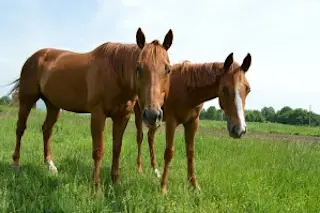Photo: Flickr/Viva Granda PhotographyIf you've ever spent time with a horse, you've probably noticed how mobile their ears are; not only can they point up or lie flat, but they can swivel nearly 180 degrees! Horse handlers harness this mobility to tell a lot about how a horse is feeling by ear-watching. But it is less clear whether horses use their ears to communicate to each other. To test this, British scientists let horses choose to feed from one of two buckets. Behind the buckets was a life-sized photo of a horse's head, facing either to the right or left. If the real horse could see both the ears and eyes of the horse in the picture, it would pick whichever bucket the picture-horse was pointing towards. But if either the ears or eyes were covered, the horse ignored the picture and chose a random bucket, showing that horses watch ...
Horses use their ears to communicate with each other.
Discover how horses use their ears to communicate, revealing essential insights into their social interactions and attention cues.
More on Discover
Stay Curious
SubscribeTo The Magazine
Save up to 40% off the cover price when you subscribe to Discover magazine.
Subscribe













